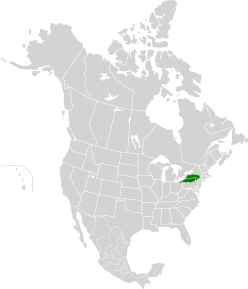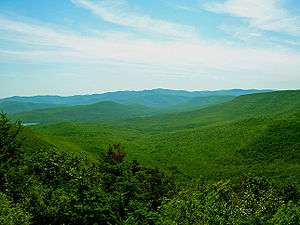Allegheny Highlands forests
| Allegheny Highlands forests | |
|---|---|
|
Slide Mountain and surrounding peaks in the Catskill Mountains | |
 | |
| Ecology | |
| Biome | Temperate broadleaf and mixed forests |
| Borders | |
| Bird species | 198[1] |
| Mammal species | 58[1] |
| Geography | |
| Area | 116,400 km2 (44,900 sq mi) |
| Country | United States |
| States | Pennsylvania, New York and Ohio |
| Conservation | |
| Habitat loss | 23.3%[1] |
| Protected | 16.9%[1] |
The Allegheny Highlands forests are a temperate broadleaf and mixed forests ecoregion of North America, as defined by the World Wildlife Fund.
Setting
The ecoregion consists of four separate blocks of mixed forest surrounded by lower lying areas of hardwood forest as follows: the Northern Allegheny Plateau in New York State and Pennsylvania including the Catskill Mountains, the Poconos, the Finger Lakes and French Creek areas; areas of the north and central Appalachians; the western Allegheny Plateau in western Pennsylvania and Ohio; and the upland plain around Lake Erie and Lake Ontario.
Climate
The ecoregion has a humid continental climate with warm to hot summers.
Flora
Most of this forest was cleared in the late-19th and early-20th centuries. Although all individual trees species still remain, their quantities and distribution are radically different from the forest's original state. The Finger Lakes area has a particularly rich mixture of woodland, while the pinewoods in the Pocono Mountains are a unique habitat.[2]
Upland hardwood forests include red maple (Acer rubrum), American beech (Fagus grandifolia), black cherry (Prunus serotina), and black birch (Betula lenta).[3]
Allegheny hardwood forests consist of black cherry, white ash (Fraxinus americana), and tulip poplar (Liriodendron tulipifera).[3]
Mixed-oak forests of northern red oak (Quercus rubra), white oak (Quercus alba), eastern black oak (Quercus velutina), and scarlet oak (Quercus coccinea) grow along major river drainages and on steep, drier slopes.[3]
Northern hardwood forests include sugar maple (Acer saccharum) and American beech. Also common are yellow birch (Betula alleghaniensis), eastern hemlock (Tsuga canadensis), red maple, black cherry, and eastern white pine (Pinus strobus).[3][4] Hemlock tends to follow stream drainages, while white pine prefers drier ridgetops.[3] White ash, American elm (Ulmus americana), basswood (Tilia americana), and hop hornbeam (Ostrya virginiana) can occur locally.[4]
Boreal forests occur at high elevations, particularly on the peaks of the Catskill Mountains. These forests include balsam fir (Abies balsamea), paper birch (Betula papyrifera), mountain ash (Sorbus americana), and red cherry (Prunus pensylvanica). Wild raisin (Viburnum cassinoides) and mountain holly (Ilex mucronata) are shrubs that grow in high elevation swamps, bogs, and ledgetops.[4]
Fauna
Wildlife of the forest includes bobcat, American black bear, and coyote, and flying squirrel. Birds include barred owl.
Threats and preservation
As well as logging and clearance for farmland another factor that affects the make-up of the forest is grazing, especially by deer, while suburban and tourist development is resulting in more habitat loss in the Catskills and the Finger Lakes especially. Protected areas include Allegheny National Forest, Sproul State Forest, Cook Forest State Park, Hammersley Wild Area, Moraine State Park, and Woodbourne Forest and Wildlife Preserve in Pennsylvania, and Allegany State Park, Catskill Park, Bergen-Byron Swamp and the shores of Hemlock Lake and Canadice Lakes in New York.
References
- 1 2 3 4 Hoekstra, J. M.; Molnar, J. L.; Jennings, M.; Revenga, C.; Spalding, M. D.; Boucher, T. M.; Robertson, J. C.; Heibel, T. J.; Ellison, K. (2010). The Atlas of Global Conservation: Changes, Challenges, and Opportunities to Make a Difference. University of California Press. ISBN 978-0-520-26256-0.
- ↑ Allegheny Highlands forests
- 1 2 3 4 5 "Allegheny National Forest Final Environmental Impact Statement". United States Forest Service. March 2007: 3–77 to 3–86.
- 1 2 3 Kudish, Michael (2000). The Catskill Forest: A History. Purple Mountain Press, Ltd. ISBN 978-1-930098-02-2.
External links
- "Allegheny Highlands forests". Terrestrial Ecoregions. World Wildlife Fund.
- Catskill Flora Project
